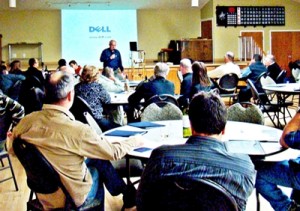Article appeared in the Dec. 15, 2011 issue of the Interlake Spectator…

The East Interlake Conservation District held its Annual General Meeting at the Fraserwood Hall, on Dec. 5. Fifty people, mainly EICD, council members, and citizen reps from EICD’s catchment area, attended.
The EICD membership includes representatives from the Province of Manitoba, the City of Selkirk, The towns of Arborg, Stonewall, Teulon, and Winnipeg Beach; the Villages of Dunnottar and Riverton, and the Rural Municipalities of Armstrong, Bifrost, Fisher, Gimli, Rockwood, Rosser, St. Andrews, West St. Paul, and Woodlands.
Chairman of EICD and Reeve of the RM of Bifrost, Harold Foster, and EICD manager, Armand Belanger gave their reports before dinner.
Foster brought forward an idea discussed, at the recent Association of Manitoba Municipalities (AMM) convention, for a formula for municipalities to help fund the conservation district.
“A committee will be formed to come up with a plan that is fair,” Foster said.
Foster also discussed the need for better drainage for Fish Lake and Dennis Lake, and dealing with bottleneck spots.
Belanger followed with a brief discussion about partnerships between EICD and various levels of government, and went over what EICD accomplished in 2011.
Belanger then gave an overview of EICD’s very in depth website. He walked everyone through all the links.
After dinner, Richard Gosshans, a wetland scientist with the International Institute for Sustainable Development, gave an excellent presentation called, “Finding good use for Cattails”.
He explained the research in the Netley-Libau wetland area on a bio-energy project which is looking at ways to use Cattails for energy, fertilizer,
for creating bio-plastics and bio-fibres, as well as using them as a commodity for gaining carbon credits.
Managing cattails may also be way the perfect way to deal with the overload of phosphorous moving from the Red River Basin into Lake Winnipeg, the research suggests. Phosphorous from the Red River Basin accounts for about 60 per cent of the phosphorous into the lake. It has been found that Cattails are extremely efficient absorbers of the element.
The researchers are currently trying to come up with the best way to harvest Cattails from the marshes, without harming the sensitive eco-system.
The evening was topped off with elections of Sub-district Chairpersons, EICD Board Chairperson, and EICD Vice-Chairperson.
There are four sub-districts along watershed boundaries, with a board chair from each sub-district appointed to the main EICD Board, as well as an appointed official from the Province of Manitoba.


